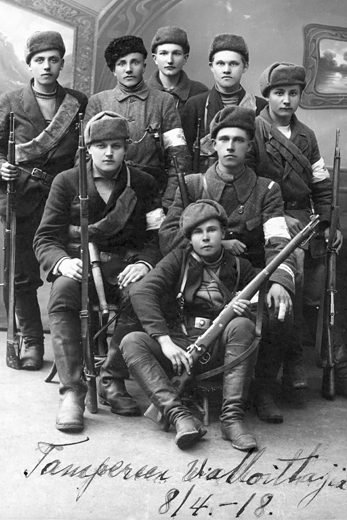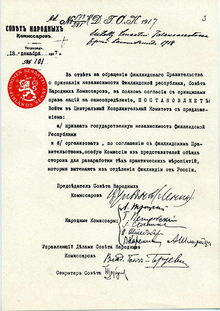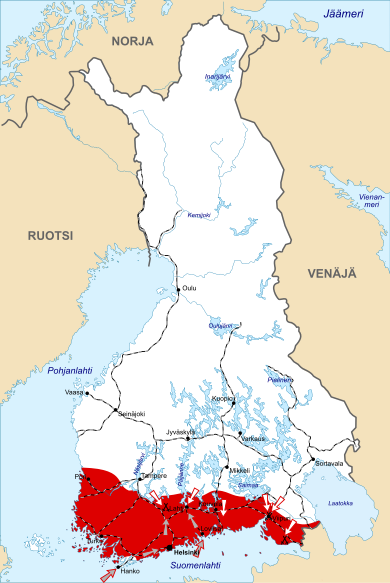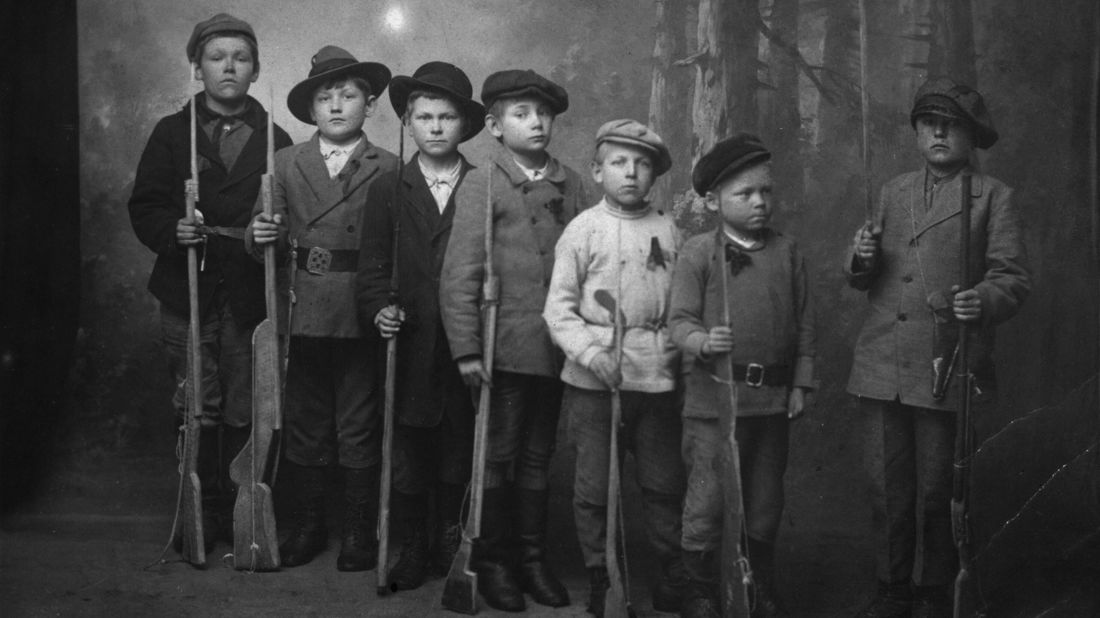Red

White
-------------

The Bolsheviks' recognition of Finnish independence. Some minutes before midnight on 31 December 1917, two men with opposite worldviews, P.E. Svinhufvud and Lenin shook hands German requirement Soviet Russia (Lenin) approves Brest-Litovsk peace agreement Brest-Litovsky's peace was March 3, 1918
------------
In the years before the conflict, Finnish society had experienced rapid population growth, industrialization, pre-urbanization and the rise of a comprehensive labour movement. The country's political and governmental systems were in an unstable phase of democratization and modernization. The socio-economic condition and education of the population had gradually improved, as well as national thinking and cultural life had awakened. World War I led to the collapse of the Russian Empire and a power struggle, militarization and escalating crisis between the left-leaning Finnish labour movement and the Finnish conservatives.
Red Guard soldiers training with Winchester 1895's during the Finnish Civil War
Winchester 1895 carbine was russian army model, users russian navy and cavalry,
The rifle load only five cartridges, same like bolt lock rifle, manufactured and sold only for Russian army, and model.
The Reds carried out an unsuccessful general offensive in February 1918, supplied with weapons by Soviet Russia. A counteroffensive by the Whites began in March, reinforced by the German Empire's military detachments in April. The decisive engagements were the Battles of Tampere and Vyborg (Finnish: Viipuri; Swedish: Viborg), won by the Whites, and the Battles of Helsinki and Lahti, won by German troops, leading to overall victory for the Whites and the German forces. Political terror became a part of this warfare. Around 12,500 Red prisoners of war died of malnutrition and disease in camps. Approximately 39,000 people, of whom 36,000 were Finns, perished in the conflict.

In the aftermath, the Finns passed from Russian governance to the German sphere of influence with a plan to establish a German-led Finnish monarchy. The scheme was cancelled with the defeat of Germany in World War I and Finland instead emerged as an independent, democratic republic. The Civil War divided the nation for decades. Finnish society was reunited through social compromises based on a long-term culture of moderate politics and religion and the post-war economic recovery.
The main factor behind the Finnish Civil War was a political crisis arising out of World War I. Under the pressures of the Great War, the Russian Empire collapsed, leading to the February and October Revolutions in 1917. This breakdown caused a large power vacuum and a subsequent struggle for dominance in Eastern Europe. The Grand Duchy of Finland, part of the Russian Empire since 1809, became embroiled in the turmoil. Geopolitically less important than the continental Moscow-Warsaw gateway, the northerly Finnish ground, isolated by the Baltic Sea was a peaceful side front until early 1918.

Child soldiers and wood guns
Upper picture White, bottom Red
The German Empire saw Eastern Europe - primarily Russia - as a major source of vital products and raw materials, both during World War I and for the future. Her resources overstretched by the two-front war, Germany pursued a policy of breaking up Russia from within by providing financial support to revolutionary groups, such as the Bolsheviks and the Socialist Revolutionary Party, and to radical, separatist factions, such as the Finnish activist movement leaning toward Germanism.
Between 30 and 40 million marks were spent on this endeavour. Controlling the Finnish area would allow the Imperial German Army to penetrate Petrograd and the Kola Peninsula, an area rich in raw materials for the mining industry. Finland possessed large ore reserves and a well-developed forest industry.

A map of Russia's Grand Duchy of Finland from 1825. The map texts are in Russian and Swedish.
----
From 1809 to 1898, a period called Pax Russica, the peripheral authority of the Finns gradually increased, and Russo-Finnish relations were exceptionally peaceful in comparison with other parts of the Russian Empire. Russia's defeat in the Crimean War in the 1850s led to attempts to speed up the modernization of the country. This caused more than 50 years of economic, industrial, cultural and educational progress in the Grand Duchy of Finland, including an improvement in the status of the Finnish language. All this encouraged Finnish nationalism and cultural unity through the birth of the Fennoman movement, which bound the Finns to the domestic administration and led to the idea that the Grand Duchy was an increasingly autonomous state of the Russian Empire.
In 1899, the Russian Empire initiated a policy of integration through the Russification of Finland. The strengthened, pan-slavist central power tried to unite the "Russian Multinational Dynastic Union" as the military and strategic situation of Russia became more perilous due of the rise of Germany and Japan.
Finns called the increased military and administrative control, "the First Period of Oppression", and for the first time Finnish politicians drew up plans for disengagement from Russia or sovereignty for Finland.
In the struggle against integration, activists drawn from sections of the working class and the Swedish-speaking intelligentsia carried out terrorist acts. During World War I and the rise of Germanism, the pro-Swedish Svecomans began their covert collaboration with Imperial Germany and, from 1915 to 1917, a Jäger (Finnish: jääkäri; Swedish: jägar) battalion consisting of 1,900 Finnish volunteers was trained in Germany



Ei kommentteja:
Lähetä kommentti
Any explosive ammunition or empty cores, you can put in this.